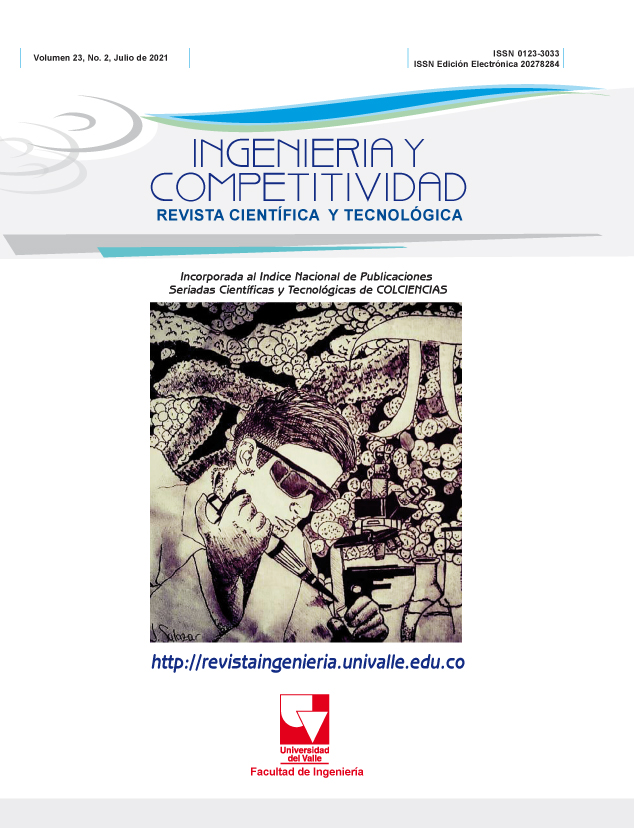Desarrollo de un sistema de iluminación portátil alimentado por energía solar fotovoltaica: Caso de aplicación comunidad Chucheros-Buenaventura
Contenido principal del artículo
Este artículo presenta el desarrollo de un sistema de iluminación portátil alimentado por energía solar fotovoltaica para uso de la comunidad Chucheros-Buenaventura. Se tuvieron en cuenta las necesidades básicas de la comunidad y la disponibilidad de los recursos energéticos naturales, así como el uso de componentes amigables con el medio ambiente, portabilidad y multifuncionalidad del sistema de iluminación con el propósito de evaluar su impacto ambiental y autonomía energética. El análisis de diferentes materiales para la construcción de la carcasa del sistema logró evidenciar características favorables de la mezcla (50/50) de los materiales reciclados Polipropileno y Polietileno de alta densidad (PPr/PEADr) comparado con los demás, en cuanto a transferencia térmica y resistencia a impactos. Además, con la selección de los dispositivos electrónicos del sistema de iluminación se obtuvo una autonomía energética de aproximadamente 4 horas suministrando una corriente de 500 mA. Finalmente, el uso de tecnologías disponibles en nuestro contexto y el aprovechamiento de las energías renovables permitió el desarrollo de una luminaria solar portable que abre la posibilidad de realizar diferentes actividades básicas de las personas y aporta, no solo en el mejoramiento de la calidad de vida de estas en los hogares de las Zonas no Interconectadas (ZNI), sino también como alternativa tecnológica ambientalmente amigable de iluminación de uso general.
- Ecodiseño
- Energías renovables
- Medio ambiente
- Portabilidad
- Eco-
- Iluminación LED
(1) DANE (CO). Necesidades Básicas Insatisfechas (NBI) Censo Nacional de Población y Vivienda (CNPV) 2018. Bogotá; 2019. Available from: https://www.dane.gov.co/files/censo2018/informacion-tecnica/CNPV-2018-NBI.xlsx.
(2) UPME - Unidad de Planeación Minero Energética (CO). Plan Indicativo de Expansión de Cobertura de Energía Eléctrica PIEC 2016-2020. Bogotá; 2016. 48 p. Available from: http://www.upme.gov.co/Siel/Siel/Portals/0/Piec/PIEC_2016-2020_PublicarDic202016.pdf.
(3) IPSE (CO). Planes de energización rural sostenible - PERS - herramienta de información para el desarrollo rural. Bogotá; 2016. 35 p. Available from: https://www1.upme.gov.co/Hemeroteca/Memorias/Memorias_dia_UPME_2016/Herramienta_informacion_Pers.pdf.
(4) Bueno-Lopez M, Rodríguez-Sanchez P and Molinas M. Sustainable model for rural electrification projects in Non-Interconnected Areas in Colombia. In: IEEE Global Humanitarian Technology Conference (GHTC). Seattle, USA; 2019. p. 1-6. https://doi.org/10.1109/GHTC46095.2019.9033104.
(5) Enríquez S. Estudio del impacto ambiental de fuentes de luz durante: su producción, tiempo de vida y desecho. [Master’s Thesis]. Barcelona, España; Universidad Politécnica de Cataluña: 2012. Available from: https://wwwaie.webs.upc.edu/maema/wp-content/uploads/2016/07/TESINA-Enriquez-Santiago-.pdf.
(6) Mills E. Identifying and reducing the health and safety impacts of fuel-based lighting. Energy for Sustainable Development. 2016;30:39-50. https://doi.org/10.1016/j.esd.2015.11.002.
(7) Barki DT, Barki B. and Habbu G. Creating global awareness for eliminating light poverty in the world: To replace hazardous kerosene lamps with clean and safe solar lamps. In: 33rd IEEE Photovoltaic Specialists Conference. San Diego, USA; 2008. p. 1-5. https://doi.org/10.1109/PVSC.2008.4922825.
(8) Lam NL, Muhwezi G, Isabirye F, Harrison K, Ruiz-Mercado I, Amukoye E et al. Exposure reductions associated with introduction of solar lamps to kerosene lamp‐using households in Busia County, Kenya. Indoor Air. 2018;28(2): 218-27. https://doi.org/10.1111/ina.12433.
(9) UPME - Unidad de Planeación Minero Energética (CO). Atlas de radiación de Colombia. Bogotá; 2005. 175 p. Available from: https://biblioteca.minminas.gov.co/pdf/Atlas%20de%20radiaci%C3%B3n%20solar%20Colombia.pdf.
(10) Ospino-Castro A, Robles-Algarín C, Tobón-Perez J, Peña-Gallardo R and Acosta-Coll M. Financing of Residential Rooftop Photovoltaic Projects Under a Net Metering Policy Framework: The Case of the Colombian Caribbean Region. International Journal of Energy Economics and Policy. 2020;10(6):337-346. https://doi.org/10.32479/ijeep.9560.
(11) Rodríguez-Urrego D, Rodríguez-Urrego L. Photovoltaic energy in Colombia: Current status, inventory, policies and future prospects. Renewable and Sustainable Energy Reviews. 2018;92:160-70. https://doi.org/10.1016/j.rser.2018.04.065.
(12) Yasin MS, Islam MS, Biswas T and Rahman MS. Design of a low-cost lighting system for the rural areas of Bangladesh. In: International Conference on Innovations in Science, Engineering and Technology (ICISET). Dhaka; 2016. p. 1-4. https://doi.org/10.1109/ICISET.2016.7856504.
(13) Salamanca-Avila S. Propuesta de diseño de un sistema de energía solar fotovoltaica. Caso de aplicación en la ciudad de Bogotá. Revista Científica. 2017;3(30):263-77. https://doi.org/10.14483/23448350.12213.
(14) GREENPEACE (CO). Mejor sin plásticos – La contaminación plástica en Colombia y el mundo. 2018, 10 p. Available from: http://greenpeace.co/pdf/reporte_plasticos.pdf.
(15) INVEMAR (CO). Estado del ambiente y los ecosistemas marinos y costeros. En: Informe del Estado de los Ambientes Marinos y Costeros en Colombia. Santa Marta; 2017. pp. 31-73. Available from: http://www.invemar.org.co/documents/10182/14479/IER_2017_baja_Final.pdf/76690566-f6e1-4610-906f-1c49c610b2c8.
(16) INVEMAR (CO). Diagnóstico y evaluación de la calidad de las aguas marinas y costeras en el Caribe y Pacífico colombianos – Informe Técnico 2016. Santa Marta; 2017. 265 p. Available from: http://www.invemar.org.co/documents/10182/14479/Informe+REDCAM+2016.pdf/b21d50f5-cd2d-4926-a016-b321cc9659e7.
(17) Salazar EA, Arroyave JF, Moreno IY. Desarrollo de vivienda ecosostenible para sectores vulnerables. Ingeniería y Competitividad. 2014;16(1):249-59. https://doi.org/10.25100/iyc.v16i1.3729.
Descargas

Esta obra está bajo una licencia internacional Creative Commons Atribución-NoComercial-CompartirIgual 4.0.
Los autores que publican en esta revista están de acuerdo con los siguientes términos:
Los autores ceden los derechos patrimoniales a la revista y a la Universidad del Valle sobre los manuscritos aceptados, pero podrán hacer los reusos que consideren pertinentes por motivos profesionales, educativos, académicos o científicos, de acuerdo con los términos de la licencia que otorga la revista a todos sus artículos.
Los artículos serán publicados bajo la licencia Creative Commons 4.0 BY-NC-SA (de atribución, no comercial, sin obras derivadas).





